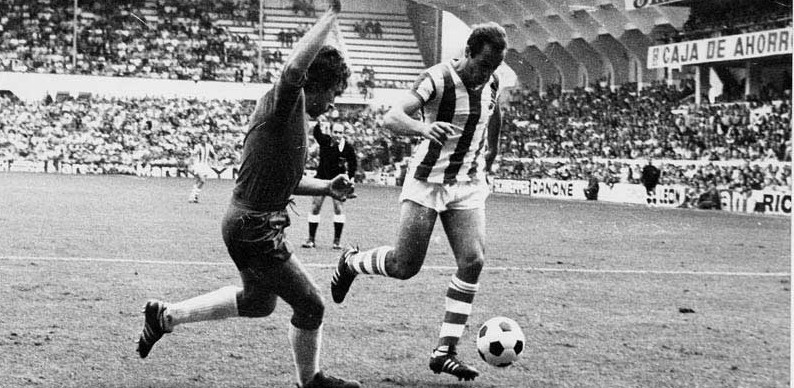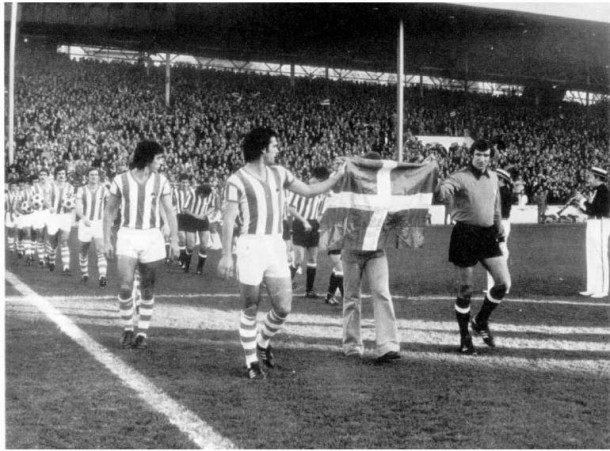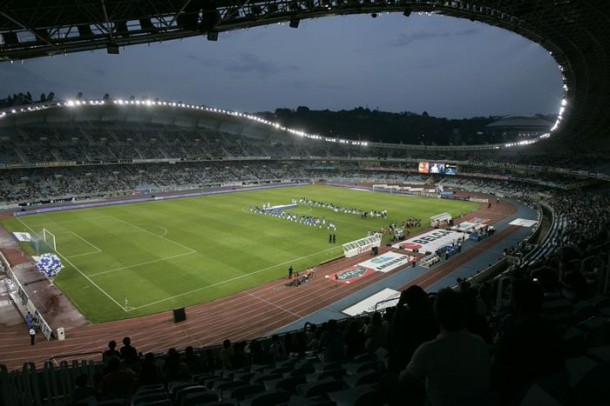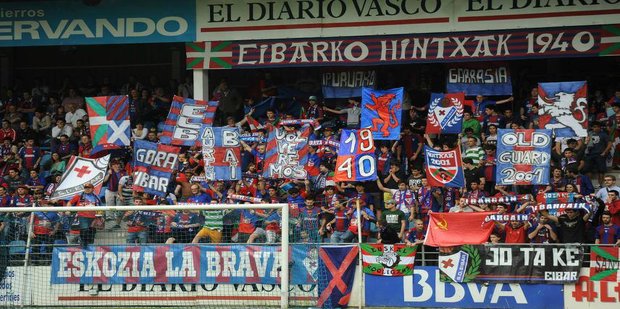- S.D. Eibar ready for maiden La Liga outing
- SD Eibar stengthen ahead of debut La Liga season
- Can ‘Super Mario’ live up to expectations in Madrid?
- MAN IN THE GROUND – Brentford 0 – 4 Osasuna
- Historic Basque derby welcomes S.D. Eibar to La Liga
- Munich to Madrid, via Brazil – Tony Kroos
- Rakitic in Spanish Switch
- Can Spain find redemption in Rio?
- Viva Espana! A season of redemption for Spanish football
- From the old to the new: who can fill the void in years to come for La Roja?
Big in the Basque Country – The Stadiums of Real Sociedad
- Updated: 12 October, 2012

Real Sociedad may have used three stadiums in its 102 years as a football club, but some 18 years after closing, it is Atotxa that is still viewed as the club’s spiritual home some. Life may have started out at the Campo Hípico de Ondarreta, the city’s old racecourse, but it was in 1913 that Sociedad put down its roots at the mythical Campo de Futbol Atotxa.
Atotxa, was cramped, crumbling and hopelessly inadequate. It was also atmospheric, intimidating and above all, it was home. Wedged between the main railway line, the fruit market and a 20 storey office block, it was lovable, but ultimately doomed.
Built in 1913 and inaugurated with a match against perennial rivals Athletic Club de Bilbao, Atotxa saw its one and only international match on 28 January 1923, when France popped over the border and politely lost 3-0. On 24 May of the following year, it hosted the Cup Final. Fittingly, fellow Basques Real Union prevailed with a 1-0 victory over Real Madrid.
In its early days, Atotxa featured a very ornate main stand. Unusually for a wooden construction of this era, it was twin decked and ran the length of the pitch. Opposite the main stand stood a large open bank of terracing, whilst either end of the ground featured thin strips of bleachers. It then began to develop in a rather piece-meal fashion as assorted covers were added.
As the club started to establish itself in La Primera, the main stand was replaced with a curious structure that had a central section of three narrow tiers of seats, either side of which stood larger banks of seats under a curved roof. In the late fifties, the municipality acquired land at either end of the ground and built two identical stands that featured narrow terraces up tight to the touchline and covered seating behind.
Finally, the open bank which had featured a rickety assortment of roofs at the back of the terrace, got a more substantial cover in the 1960’s, with a few rows of seats added at the rear.
As years passed however, it lagged far behind the stadium developments found elsewhere in Spain, and by the time of the 1982 World Cup, it was overlooked as a host. Simon Inglis, in his book The Football Grounds of Europe was well aware of Atotxa’s inadequacies, but loved it all the same. He described the stadium thus… “Holding 27,400, the ground is an intimidating hothouse for visitors, covered on all four sides (each with a different style of roof) and barely a metre between its touchlines and perimeter fence.
The white north stand roof, apparently concrete, is actually lath and plaster, and the general facilities are basic, to say the least.”
But Sociedad’s fans didn’t care, particularly when the team won back to back titles in 1981 and 1982, followed by a Copa del Rey win in 1987. This success however, would prove Atotxa’s undoing. With no space to develop and better facilities for players, officials and fans a must, Real Sociedad played its final match at the stadium on 22 June 1993.
The stadium lingered on for a few more years, before being finally demolished in 1999. The site is now occupied by housing and the fruit market is where the new Palacio de Justicia stands. For some strange reason, the municipality have kept the truly awful office block.
 Atotxa was also the scene of one of the most symbolic actions in Spanish football history. On 5 December 1976, Sociedad’s Inaxio Kortabarria and Athletic’s Jose Angel Iribar walked onto the pitch carrying the Ikurriña, the flag of the Basque nation.
Atotxa was also the scene of one of the most symbolic actions in Spanish football history. On 5 December 1976, Sociedad’s Inaxio Kortabarria and Athletic’s Jose Angel Iribar walked onto the pitch carrying the Ikurriña, the flag of the Basque nation.
It was almost exactly a year after General Franco’s funeral and the years of oppression by his Nationalist regime were still a fresh and open wound. The flag was still outlawed at the time, but this was a sign of unity and defiance on behalf of the Basque nation.
When Real Sociedad moved to Anoeta in 1993 the change in culture must have been immense. It was not just a mile or so to the south of this beautiful coastal city, but a world away from the intense and claustrophobic surroundings of Atotxa. The Penas and Ultras that were used to standing less than five feet away from the goal-mouth action were now up to 50 metres away.
Work had started on the construction of Anoeta in late 1990, on the site of the city’s old municipal athletics stadium, which had originally opened in 1950. The budget for the build was the equivalent of 21 million euros and the original specification had a capacity of 29,000 seats spread over two undulating tiers.
It was inaugurated on 29 June 1993 with the staging of the European Junior Athletics Championships and saw its first football match, a friendly between Sociedad and Real Madrid, on 13 August 1993. The north and south ends of the ground were developed further in 1998 with the addition of a mezzanine tier between the existing two levels.
Anoeta is a bit like a Prom Queen. It’s Beautiful to behold, has fabulous curves, but it’s emotionally vapid. Owned by the Municipality, the capacity is only slightly larger than Atotxa at 32,076. The roof undulates and peaks on each side of the pitch, under which sit large two-tiers of seating. These sweep away to the lower ends, which include between their two tiers a third mezzanine level.
It’s a smaller version of the Olympic Stadium in Seoul and I am sure it works well as an athletics venue, but I don’t recall any major championships being held here. Sure it gets the ubiquitous stadium concerts from U2/Rolling Stones/Springsteen and Rugby has featured with Bayonne and Biarritz popping over the border, but as a football stadium? Nah!
Whilst looks very attractive and has weathered surprisingly well, it is still an athletics stadium with a football pitch in the middle. And I think you know what I feel about that!
_____________________________
To read more on the footballing stadiums of Spain, visit Chris’s excellent site Estadios de fútbol en España







One Comment
You must be logged in to post a comment Login